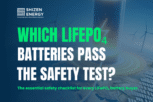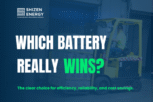
Introduction: Why Do We Need to Know the Price of Li-ion Batteries in 2025?
Warehouses, logistics fleets and industrial operations are getting electrified across India. Lithium-ion forklift batteries are the enabler behind this shift from lead acid to lithium for forklifts, stackers and AGVs. Buying and installing the right batteries are critical decisions that impact your total cost of ownership, ROI analysis and battery technology choice.
However, most buyers get overwhelmed by the huge price variations, rapidly changing market and technical jargon. This comprehensive blog post answers all your questions about lithium-ion battery cost drivers in 2025 to help you make smarter, future-proof buying decisions.
Section 1: Raw Materials (Battery Cells) — The Base Cost of a Battery
Raw materials are the most significant factor in the cost of a lithium-ion battery, contributing more than 50%. The primary raw materials are lithium, cobalt, nickel and other ingredients used in cell manufacturing. These are mostly globally traded commodities with prices that fluctuate based on demand-supply factors, mining production, and geopolitical events.
Raw materials – Foundation of Battery costs
- Lithium: India is a net importer of lithium, so prices are affected by global supply chains, currency fluctuations, and import tariffs.
- Cobalt: Most of the world’s cobalt supply comes from the DRC, and faces ethical sourcing and supply risks.
- Nickel: Demand is increasing due to the high-energy-density battery chemistries (NMC811 and NMC833).
| Material | Role | 2025 Price Trend |
|---|---|---|
| Lithium | Energy carrier | Stable to slightly rising |
| Cobalt | Stability and energy | Volatile with slight decrease |
| Nickel | Energy density | Rising |
The key point: A 10% change in the cost of raw materials can change the battery pack price by 5–7%.
Section 2: Battery Chemistry & Type (NMC vs. LFP) and Price Difference
Battery chemistry is another major factor influencing the price and performance of a battery. The two most popular lithium-ion battery types for industrial and material handling applications are:
| Chemistry | Typical Use | 2025 Cost (Rupee/kWh) | Pros | Cons |
|---|---|---|---|---|
| NMC (Nickel Manganese Cobalt) | EVs; forklifts; premium storage | 15000-20000 | High energy density; long life | Higher cost; cobalt dependency |
| LFP (Lithium Iron Phosphate) | Forklifts; stackers; AGVs | 12000-15000 | Safer; cheaper; long cycle life | Lower energy density |
- LFP: The most popular chemistry for lithium forklift batteries because it’s safer, cheaper and offers longer cycle life
- NMC: Preferred for higher energy density requirements or space constraints.
Tip: The choice of battery type and chemistry depends on your application and performance requirements (refer our blog “LFP vs. NMC: Which Li-ion Forklift Battery Chemistry is Better?“).
Comparison Table: Li-ion Forklift Batteries vs. Lead Acid Forklift Batteries
| Feature | Lithium Forklift Battery | Lead-Acid Forklift Battery |
|---|---|---|
| Upfront Cost | Higher | Lower |
| Cycle Life | 2000-5000 | 500-1200 |
| Maintenance | Minimal | Regular (watering; cleaning) |
| Charging Time | 2-3 hours | 8-10 hours |
| Energy Efficiency | 90-95% | 70-80% |
| Total Cost of Ownership | Lower over 5 years | Higher over 5 years |
Section 3: Scale, Efficiency and Automation of the Manufacturing Process
The economies of scale and manufacturing process efficiencies are also bringing down battery prices. Large and automated manufacturing facilities can reduce the cost per unit by:
- Bulk procurement of raw materials
- Adopting advanced cell assembly lines and quality testing
- Optimizing labor and overhead expenses.
India’s lithium-ion battery market is currently import-dependent, with 80% of the cells being imported from other countries. However, the government’s PLI scheme for manufacturing and Shizan Energy India’s local production are expected to reduce costs and ensure supply chain resilience by 2025.
Cost Breakdown Example (FY25, LFP Forklift Battery):
| Component | Cost (Rupee/kWh) |
|---|---|
| Battery Cells | 8000-10000 |
| BMS (Battery Management System) | 1500-2000 |
| Thermal Management | 1000-1500 |
| Inverters | 2000-2500 |
| Assembly & Overheads | 1500-2000 |
| Total | 12000-15000 |
Section 4: Government Policies, Subsidies and Tariffs
Government policies and incentives also directly affect battery prices:
- GST: 18% on lithium-ion batteries ( Subject to vary depending on Govt changes)
- Custom Duty: 20–25% on imported batteries and cells
- PLI Schemes: Providing subsidies to manufacturers to set up local plants, which is expected to lower costs by 5–10% in the coming years.
- Battery Subsidies: 20–40% subsidies available for large-scale BESS projects under government renewable energy schemes.
Tip: Buyers can save on import duties and take advantage of government subsidies by opting for local sourcing and assembly (like Shizen Energy India does).
Section 5: Supply-Demand Trends & Technological Innovation
The increasing demand for lithium-ion batteries in India (20–25% CAGR) is creating both opportunities and challenges for the industry. The demand is driven by electric vehicles, renewable energy, industrial automation and consumer electronics. The demand for lithium-ion batteries is expected to reach 135GWh by 2030.
- High Demand: Creates short-term price volatility, especially for high-demand battery chemistries and applications.
- Technological Improvements: Better cell designs, BMS software, and recycling are driving down costs and improving performance.
- Local Manufacturing: Expected to lower costs and reduce import dependence, thus, leading to price stabilization.
Price Trend Prediction for 2025
| Application | 2024 Avg. Price (Rs/kWh) | 2025 Projected Price (Rs/kWh) | Trend |
|---|---|---|---|
| Forklift Lithium Battery | 15000 | 12000-15000 | Down (10-20%) |
| E-Rickshaw Battery | 14000 | 12000-14000 | Down (7-10%) |
| Solar Inverter Battery | 13000 | 11000-13000 | Down (8-15%) |
| Energy Storage System | 18000-22000 | 15000-20000 | Down (10-15%) |
1. Cost Breakdown Pie Chart (FY25, LFP Forklift Battery)
- Battery Cells: 65%
- BMS: 13%
- Thermal Management: 10%
- Inverters: 7%
- Assembly and Overheads: 5%
2. Price Trend Line Graph (2023–2025)
- Displaying the downward trend in per kWh prices of forklift, e-rickshaw and solar inverter batteries.
3. Comparison Table: Li-ion vs. Lead Acid Forklift Batteries
(Refer above)
Conclusion
The average cost of lithium-ion batteries in India is decreasing, but there are significant variations based on raw materials, battery type, manufacturing scale, government policy and market forces. Warehouse managers, logistics operators and procurement professionals need to understand these factors to make informed choices, maximize ROI and avoid costly errors.
Are you ready to electrify your fleet or energy storage system? Talk to trusted suppliers such as Shizen Energy India for an accurate cost estimate and expert advice on the right material handling battery solution for your application. Don’t let the confusion about prices and battery technology hold back your business. Empower your operations and stay ahead with the right battery solution for a greener, more efficient future.
Contact Shizen Energy India, India’s top lithium battery manufacturer for forklifts, material handling, solar inverters and energy storage solutions for a detailed quote or to discuss your specific requirements.




